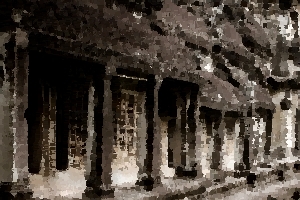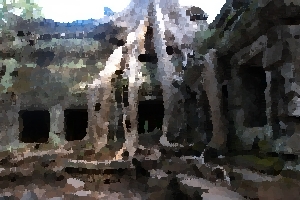The temple was built for King Suryavarman II in the early 12th century. It began as the king’s state temple close to the capital city.
 Ancient interior architecture of the Angkor Wat. [CC] credit.
Ancient interior architecture of the Angkor Wat. [CC] credit.When the king for whom it was constructed, King Suryavarman II, died, the temple's construction was interrupted and remains today in its unfinished state in several different places. The temple also suffered in 1177 at the hands of the Chams, ancient traditional enemies. When the new king, Jayavarman VII, came to power, a new state temple was built a few kilometers to the north of Angkor Wat.
 Impressive tree roots covering an Angkor Wat structure. [Report image]
Impressive tree roots covering an Angkor Wat structure. [Report image]Today, the temple is Theravada Buddhist, and although it was neglected after the new state temple was built, it was never truly abandoned. This is unusual for temples of the area and the day, and it remains in almost the same state it was before the change of power and death of the king it was built for. The other thing that allows the temple to remain mostly intact is its moat, which protects it from being approached and damaged by the jungle or anything in it. Most of the same day's temples are either partially or completely in ruins, and none are being used presently. Still, Angkor Wat is not only completely functional, but it is also actually in use.
Exploration and restauration
Antonio da Magdalena, a Portuguese monk, was the first westerner to visit Angkor Wat in 1586. He was immensely impressed and rightfully thought that geniuses had constructed it with unbelievable splendor. However, the temple did not really become popularized in Western culture until the mid 19th century when Henri Mouhot, a French traveler, published his travel notes that it was a temple to rival Solomon's.
The Angkor Wat underwent significant restoration in the 20th century, most importantly removing accumulated dirt and vegetation. In recent times, the temple has also seen a few adjustments. Since the 1990s, there has been a huge influx of tourists that have been visiting Angkor Wat. The temple is now a UNESCO World Heritage Site since 1992.
Now a national symbol
The magnificent Angkor Wat has become a symbol of Cambodia. It appears on the national flag of the country and is its most famous attraction. It has also become an important part of some of the Cambodian population who can profit from tourism.